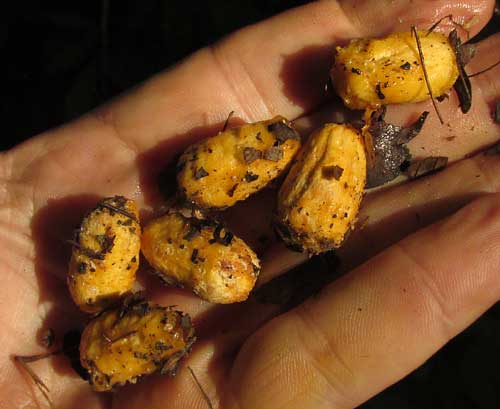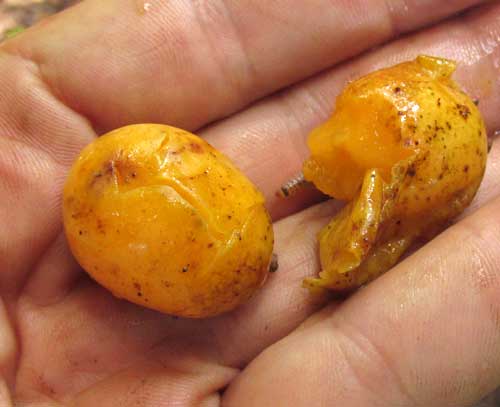Excerpts from Jim Conrad's
Naturalist Newsletter
from the October 19, 2018 Newsletter issued from Rancho Regenesis in the woods ±4kms west of Ek Balam Ruins; elevation ~40m (~130 ft), N~20.876°, W~88.170°; central Yucatán, MÉXICO
YELLOW MOMBIN FRUITING
Lately, along the rocky forest trail that I jog each morning at dawn, in a certain spot the ground has been littered with the peanut-size items shown below:

Those are seeds, and the reason they're covered with dirt and tatters of dry leaves is that the fruit's skin and flesh have been removed, leaving the seeds sticky. During the night, animals fed on the fallen fruits, leaving the seeds. Probably the main critters eating them are the coatis, or tejones, which nowadays are roaming in large groups. My Maya friend Juan told me that this week he saw a pack of about 50 coatis, mostly young, crossing the road as he biked to work. Earlier this month in Guatemala's Petén region tree species was producing fruits, and I happened to photograph some with their skins and flesh intact, shown

On the forest trail, it was easy to see which tree was dropping the fruits, for overhead there was just one big tree overarching the whole area, as shown below:

The telephoto lens showed that the tree's leaves were pinnately compound, something like walnut leaves, as seen below:

This is an important tree species in humid, lowland forests throughout tropical America and goes by many names. In English it's often called Yellow Mombin or Hog Plum. In Mexico the main name is Jobo (HO-bo). It's SPONDIAS MOMBIN, a good old Linneaus name, and a member of the Cashew, Mango or Poison Ivy Family, the Anacardiaceae.
At www.backyardnature.net/mexnat/spondias.htm we have an extensive page on the closely related, much cultivated Spondias purpurea, known in English as Spanish Plum or Red Mombin, in Spanish as ciruela, the word for "plum." Spanish Plum trees, however, are much smaller than those of Yellow Mombin -- up to 8m (26ft) as opposed to the Yellow Mombin's 20m (66ft) -- while Spanish Plum fruits are larger. The flowering clusters, or inflorescences, also are very different. Spanish Plum trees are commonly cultivated, while Yellow Mombin trees seldom are.
I first encountered Yellow Mombin while spending a few months among a family in Tamazunchale, San Luis Potosí, in east-central Mexico, gathering experiences for my first book, On the Road to Tetlama. My Nahuatl-speaking host one day brought me a tasty, even somewhat fizzy drink that at first I assumed to be a commercial product, maybe something like the old Kool-Aid powder that was mixed with water. However, my friend told me he'd made it from Jobo fruits being sold in traditional markets at that season. Later I found that not only drinks but also jellies and sherbets are made from the sharply tasting, somewhat acid fruits.
Belonging to the family in which Poison Ivy occurs, you can imagine that Yellow Mombin produces interesting chemical compounds. In traditional medicine the fruit has been used as a diuretic, and to bring down fever. The tree's bark is astringent and is used for diarrhea, hemorrhoids, gonorrhea and other problems. From the flowers a tea is brewed for stomach ache, cystitis, and such.